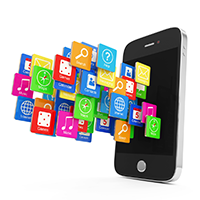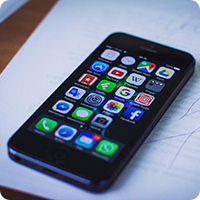
Companies are constantly searching for ways in which to further engage their customers via the use of apps, as the number of people owning a smartphone continues to increase. Aside from actions such as calling, emailing and text messaging, it’s clear to see why apps can dominate users’ mobile phone usage.
Harvard Business Review, stated that mobile consumers spend an estimated 82% of their mobile minutes on apps in comparison to the mere 18% that is spent on browsing the web, taking phone calls and texting. Furthermore, they estimated that we each have almost 40 apps on our phones, but use a mere 15 on a regular basis. However, this usage is strongly entered around a few areas: Social Media (e.g. Facebook, Twitter, Instagram), Entertainment (Youtube, Spotify), Navigation (Google Maps), Communication (WhatsApp, Viber, Tango) and News. This meant that only 5% of consumer’s mobile time is spent browsing shopping apps. This means that although consumers use apps an awful lot, merchants aren’t actually making many sales through them in comparison to their web sales.
Push notifications are not being read
A large aspect of why apps are so popular is their high levels of content, including entertainment, information, products, services, education, etc. – or a combination of such things. Consumers have reported that they enjoy the variety of experiences that apps can provide them, and in general feel that apps deliver what they need without being too intrusive.
 However, one issue which apps can encounter is as a result of their reliance on push notifications was their primary means of re-engaging the audience when they close the application. Brand Quarterly stated that almost 50% of the time consumers opt-out of receiving push notifications. This then leaves companies with very little engagement potential with half of its audience. Similar studies have found that only 6% of all push notifications result in app re-engagement by a user. The primary reason behind this is that more often than not, consumers grow irritated when a push notification pops up on their mobile devices and feel it’s too intrusive as it can interrupt whatever else they are doing. This can particularly be a nuisance when large numbers of apps are sending you push notifications simultaneously, with notifications ranging from games (“Your chickens have completed egg-laying”), to news headlines, to music updates etc.
However, one issue which apps can encounter is as a result of their reliance on push notifications was their primary means of re-engaging the audience when they close the application. Brand Quarterly stated that almost 50% of the time consumers opt-out of receiving push notifications. This then leaves companies with very little engagement potential with half of its audience. Similar studies have found that only 6% of all push notifications result in app re-engagement by a user. The primary reason behind this is that more often than not, consumers grow irritated when a push notification pops up on their mobile devices and feel it’s too intrusive as it can interrupt whatever else they are doing. This can particularly be a nuisance when large numbers of apps are sending you push notifications simultaneously, with notifications ranging from games (“Your chickens have completed egg-laying”), to news headlines, to music updates etc.
A solution which is emerging however, involves combining leveraging SMS coupled with the in-app push experience. With SMS messaging currently ‘making a comeback’, a growing number of consumers feel that text messages are a good manner in which a company can get their attention, with 64% of people feeling that organisations should use SMS-type engagement more frequently (SAP global study). Through implementing a multi-channel approach, companies couple the general acceptance of SMS with app data on user behaviour in order to deliver relevant re-engagement messages at appropriate times. Through combining a user’s phone number to their application usage, businesses can optimise what offers they deliver to the user’s medium of choice and when they deliver them. The app allows them to observe behaviour over time and businesses can then determine user communication preferences and carry out further campaigns in the most effective way possible.
SMS is the solution
 SMS is also an extremely effective promotional vehicle to introduce consumers to a brand or business’ mobile application. As SMS messages are delivered directly to the consumer’s mobile device, text messages can create a perfect opportunity to engage a customer and drive application adoption. Through implanting such technique, businesses can avoid the challenge of having their apps stand out to customers in such heavily saturated app stores.
SMS is also an extremely effective promotional vehicle to introduce consumers to a brand or business’ mobile application. As SMS messages are delivered directly to the consumer’s mobile device, text messages can create a perfect opportunity to engage a customer and drive application adoption. Through implanting such technique, businesses can avoid the challenge of having their apps stand out to customers in such heavily saturated app stores.
Furthermore, SMS holds a 90% read rate within minutes of receiving a message, far greater than the rate of email marketing, with no internet required for delivery, meaning that anyone, anywhere with a mobile phone can be reached. Consumers are already extremely familiar with SMS messaging, so the concept of receiving a text message isn’t something that requires an adjustment period for consumers, it is part of their day-to-day life.
As a growing number of customers continue to download applications, and as an increasing number of retail marketers look to leverage them for consumer engagement, retail brands will strive for ways to leverage their investments for business results and growths. This can be achieved through the inclusion of SMS into their mobile app strategies.

